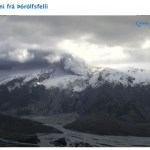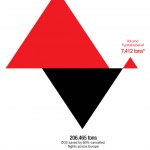eruption
Image of the Eyjafjallajökull's ash taken on May 26, 2010, courtesy of the NASA Earth Observatory.
Eruptions readers were closely following increasing tremors at Eyjafjallajökull this afternoon/evening wondering if there was a new eruption starting but with the weather not cooperating, no one was sure. However, this evening the Icelandic Met Office released a statement (Icelandic) saying that a small explosion of gas and ash did occur today. The update is only available (so far) on the Icelandic version of the IMO website - so I had to work through a Google Translate version of the story…
Sarigan Island in the northern Mariana Islands. An undersea eruption appears to be underway south of the island.
Thanks to the watchful eye of Eruptions readers, we had an inkling of this eruption the other day, but now we have confirmation that an undersea eruption is underway in the northern Mariana Islands. The exact volcano erupting is unknown, but it appears to be between Anatahan and Sarigan (see below) - both active volcanoes in the Marianas - at a depth of 300 meters. The eruption has been described by the USGS as hot water vapor and an ash plume that might have reached as high as 12…
This week has been destroyed by workshops and my last death throes with a paper I am submitting on my research in New Zealand. And to think, I thought it might settle down a little after the students left.
To news!
Ash fall on a taxi cab near Guatemala's Pacaya.
Pacaya in Guatemala erupted yesterday causing evacuations of people near the volcano and the closure of Guatemala City's main airport. Pacaya is a mere ~25 km from the capitol of this Central American nation. Tragically, a news reporter from one of the capitol's TV stations died when they were struck by volcanic debris, again…
The small steam plume from Eyjafjallajökull on May 23, 2010, where explosive eruptive activity has ceased for now.
The big news over the weekend, at least volcanically, was that Eyjafjallajökull seems to have entered a period of relative quiet. The eruption has died down dramatically, with the last ash explosion occurring two days ago. Since then, the vent has still be producing a significant steam plume that reaches 3 km / 10,000 feet, but none of the ash-laden explosions that marked the earlier parts of the eruption have occurred (meaning the airspace over the North Atlantic and Europe…
Webcam capture of Eyjafjallajökull erupting on May 2, 2010. You can see the steam plume on the middle flanks of the volcano - this is likely a lava flow coming from the summit vents.
A brief update on activity at Eyjafjallajökull:
Overnight, the lava flows from Eyjafjallajökull could be seen in the crater of the ice cap - some of the images posted by Eruptions readers are simply stunning. You can clearly see the red glow of the strombolian eruptions at the vent, and the glow of the lava flows as they had down the slope of the volcano. This has brought a lot of new melting to the snow/…
Night image of Eyjafjallajökull erupting on April 24, 2010. Image courtesy of James Ashworth.
A quick update on the Eyjafjallajökull eruption: Not a lot to report in terms of changes in the volcanic activity at the volcano. The update from the Icelandic Met Office last night sums it up nicely:
Overall activity similar as yesterday. Eruption seen from west in the morning - north crater still active. External water has not affected vent activity much since 18 April. Geologists' field observations (2-10 km from vents) show that explosivity is magmatic and that the tephra produced since 18…
A night shot of the Eyjafjallajökull eruption showing the glowing plume from the strombolian explosions and the Aurora Borealis overhead.
A quick update on the current activity at Eyjafjallajökull eruption: the eruption continues at the summit craters, but there seems to be less ash being erupted, at least yesterday. The latest update from the Icelandic Met Office suggest that things are settling down - but floods are still periodically being produced by melting of the glacier:
Volcanic tremor has been similar the last 24 hours. GPS stations around Eyjafjallajökull showed deflation…
[UPDATE: readers should be aware of a correction on the source site. The best estimate of CO2 is in fact 150,000 tons per day, not 7400, with a possible maximum of 300,000 tons per day. So the graphic is much less compelling, but the story of Joe vs the Volcano is not affected.]
Even if I can't say it, the volcano Eyjafjallajokull is great to illustrate just how ludicrous the "Volcanoes emit more CO2" argument is. Courtesy of Information Is Beautiful, here is a very telling graphic.
Is there really a need to say more?
The volcanic eruption at Eyjafjallajökull continues, but, for now at least, is a "tourist eruption", as nice as they get, with a huge flood of tourists to the mountain on clear days and a boom industry in getting sightseers out to the mountain.
From rainbowgirl on flickr via fiveprime - click through to source and full size photos
The original fissure that erupted has closed after building up a nice cinder cone, but the second fissure mostly consolidated into a single crater which continues strong.
The mountain is still rumbling and swelling, suggesting magma continues to flow under the…
Mars Reconnaissance Orbiter image of a potential plume on Pavonis Mons.
There are reports tonight that the Mars Reconnaissance Orbiter photographing the Martian surface noticed an odd plume near the summit of Pavonis Mons. The initial guess was that this plume might have been fog or an new impact on the Martian surface, but the continued presence of the plume might suggest that it is not a transient feature. One suggestion is that these could be a volcanic plume.
Now, Mars has been very volcanically active in the past - in fact the youngest flows could be as young as 20 million years old, so…
The fissure vent eruption near Eyjafjallajokull in Iceland. Image by Ãorsteinn Gunnarsson, March 22, 2010.
It has been hard to keep up with the flood of news from the Eyjafjallajokull eruption in Iceland. Eruptions readers have done a good job with getting new images, videos and info up as they happen, so you might want to peruse the comments for those sorts of tidbits (along with discussion of what might be happening).
Here is the latest:
The eruption at Fimmvörduháls (considering the eruption is actually occurring between the ice caps) could last weeks to months, which isn't too…
The steam-and-ash plume from Eyjafjallajokull in Iceland, March 22, 2010.
Overnight, the Eyjafjallajokull eruption in Iceland added to its oeuvre, producing what is being reported to be a 8-km plume. Images of the plume (above) suggest (to me) that it is very water-rich, so likely this is the expanding(?) fissure interacting with snow, ice or groundwater, producing steam explosions. These explosions have some minor ash component to them, mostly from the shattering of rapidly cooled lava, but are dominated by steam.
The eruption appears to be continuing into its third day unabated. Flights…
Eyjafjallajökull erupted tonight.
Small so far, we'll see how it develops, first eruption in 187 years.
Eruptions tracked the microquaking leading up to the eruption - fascinating and very long comment conversation and liveblogging of the precursors to the eruption. Tremendous use of blogging.
Farms south of the mountain are being evacuated, they'll see what it is like in the morning.
Should be a jökulhlaup underway (glacial flash flood).
Ashplume is headed north, airports are closed.
EUMETSAT images here
PS: according to ruv.is early sunday morning, the geoscientists driving up to the…
A shot from the Hekla webcam showing the glow from the eruption of Eyjafjallajökull that started March 20, 2010.
Quick note, but for those of you who have been following the seismicity at Eyjafjallajökull in Iceland, there is news from Iceland that an eruption has started. I will post more details as I can find them, but so far, evacuations have commenced near the volcano. It sounds like the eruption can be seen coming through the glacier on the volcano, but any real details of the style of volcanism are unknown. This is the first known eruption of Eyjafjallajökull since 1823.
UPDATE 9:40…
Sally Sennert from the Smithsonian Institution sent me an email to say that this week's USGS/Smithsonian Institute Weekly Volcanic Report will be delayed due to the inclement weather in the Washington DC area. She can't connect with the server, so the report can't be updated on the Smithsonian website ... so here it is! Look for it to show up on the Smithsonian site with all the bells and whistles as soon as DC thaws out.
And a big thanks to Sally for sending me the Report to post.
***PLEASE NOTE: Website posting of the SI/USGS Weekly Volcanic Activity Report for 3-9 February 2010 will be…
A pyroclastic flow from the February 5 vulcanian eruption of Soufriere Hills. Image courtesy of the Montserrat Volcano Observatory (MVO).
UPDATE: See some amazing images of the recent eruptive activity over on Stromboli Online. {Hat tip to the Volcanism Blog via Eruptions reader CK.}
One event that didn't eat much coverage over the weekend, at least here in the U.S., was the large eruption and explosions at Soufriere Hills on Montserrat. The volcano has had a resurgent winter since have a quiet summer of 2009. This weekend's eruption produced an ash plume that reached ~6.1 km / 20,000 feet…
Sakurajima in Japan, erupting in December 2009. Image courtesy of Photovolcanica.com
Richard Roscoe at Photovolcanica.com has just posted two great sites focusing on two of the most active volcanoes in Japan: Sakurajima and Suwanosejima. These volcanoes are almost constantly erupting with small strombolian events punctuated by occasional plinian eruptions.
Sakurajima is on the island of Kyushu (well, technically Kagoshima, but right off the coast of Kyushu) less than 10 miles / 20 km from the city of Kagoshima. The volcano has been erupting since 1955 with both explosive and effusive…

